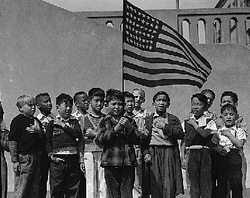Author’s note: Although I am employed by the Japanese American National Museum, this article should not be construed as coming from the National Museum. Instead, this article is my personal opinion and should be taken as such.
On December 9, 2011 the New York Times published an article titled, “The How of an Internment, but Not All the Whys,” by Edward Rothstein. This article is not only offensive but worse, it is ignorant. It is appalling that such a prestigious newspaper would print an article like it. It is sad that even after 70 years, the same lies and misinformation about Japanese Americans during World War II are still being perpetuated by a major American newspaper.
The article is a review of the new interpretive center in Heart Mountain, Wyoming, the site of one of the Japanese American concentration camps during the Second World War. The first half of the article is rather mundane. It is on page two where the most egregious comments are made. On page two, he criticizes the interpretive center for “lacking context.” It is the examples he cites that are rather unsettling.
As a public service, I would like to point out the most egregious errors and try to correct the record:
“It would help, too, to have a clearer understanding of the prewar Japanese-American population, which is now portrayed as homogenously assimilationist. But we know that 1930s Japan was a racist, militant society, convinced of the emperor’s divinity, and that a considerable number of Nisei were sent there to study.”
Mr. Rothstein’s mistakenly believes that Japanese Americans and Japanese people living in Japan are the same. They are not. In what became known as the Munson Report, Curtis B. Munson (a special representiative to the State Department) concluded in 1941 (two months before Pearl Harbor) that Japanese Americans showed “a remarkable, even extraordinary degree of loyalty [to the United States] among some of this generally suspect ethnic group.” Here’s another quote from the same report: “The Nisei are pathetically eager to show this loyalty. They are not Japanese in culture. They are foreigners to Japan. Though American citizens they are not accepted by Americans, largely because they look differently and can be easily recognized.”
“Loyalty to the emperor,” we learn at the Japanese American National Museum, was a cherished value for the Issei. Even the use of terms like Issei and Nisei shows careful attention to Japanese connections.”
Again, the Munson report makes clear that Japanese Americans were loyal. Also, I would be remiss not to mention the 442 Regimental Combat Team, a team comprised of all Japanese Americans soldiers who proved their loyalty by becoming the most highly decorated unit (for it’s size) in US military history. Many of whom gave their lives to this country to prove their loyalty.
“All of this would have amplified suspicions. In addition, the government had decoded dispatches from Japanese agents referring to their plans and successes. On May 9, 1941, one from Los Angeles read: “We have already established contacts with absolutely reliable Japanese in the San Pedro and San Diego area. Two days later, a dispatch from Seattle said, “We are securing intelligences concerning the concentration of warships within the Bremerton Naval Yard”; Japanese residents were relocated from that area in 1942.”
It is important that people know that NO Japanese American was ever convicted of spying against the United States for Japan. You have to assume that if the government had any kind of evidence against a Japanese American they would have trotted him or her out in front of the media. It would have “justified” all of their actions. But the fact that they never did is telling. It tells me that the incarceration was based on other (non military) factors, specifically racism and economics. In the Munson report, he wrote that the danger wasn’t within the Japanese American community but that “there is far more danger from Communists and people of the Bridges type on the Coast than there is from Japanese.”
“Moreover, the Japanese were known for similar espionage elsewhere, including the Philippines.”
Again, read the Munson report. I hate to sound like a broken record, but this one report debunks the whole saboteur/spy argument.
“I am not suggesting that such factors justified the relocations. Almost all of the internees were surely innocent, and most deserved the rights of citizens. The policy was racially tinged and hysterical in its sweep. But at the very least, the context demonstrates that the relocation was a response—an extreme one—to a problem. There was a geographical rationale, not simply a racial one.”
Oh God, where do I begin? First they were not “surely innocent.” They WERE innocent. Again, not a single Japanese American spy was ever found. The reason? Because there was none. You don’t have to believe me, the Munson report wrote it and Roosevelt and others in his administration knew it. Second, not racial ? Excuse me? What exactly was the rational to lock up 120,000 innocent Japanese Americans—a third of which were children and 2/3 of which were American citizens? Yes, there were German and Italians Americans that were also arrested during World War II. Some of those incarcerated were suspected of disloyalty. The key word is “some.” Some Italian and German Americans. But not all of them. Yet ALL Japanese Americans were forced out of their homes and into camps. What rational could there be but racism? In the Munson report, it states that “though [Japanese Americans are] American citizens they are not accepted by Americans, largely because they look differently and can be easily recognized.”
There were other things in the article that made me shake my head. His comments about how “easy” it was to avoid/leave the camps ignores the reality of what actually happened and the bravery of those that helped Japanese Americans (like the Quakers). The fact that he doesn’t see the similarities between what happened to Japanese Americans and Muslim/Arab Americans after 9/11 makes me sad.
I keep talking about the Munson report because it should have put to rest (in 1941) the idea of Japanese Americans being spies or saboteurs. It is the smoking gun that eventually led to an official government apology and redress.You can read the Munson report for yourself here. If you’re interested in finding “context,” I would also highly recommend reading Years of Infamy by Michi Nishiura Weglyn.
I don’t want the NYT to retract the article. I don’t want an apology. I just want Mr. Rothstein to take the time and do the research. Find out the truth. And then write an article explaining not only how he was wrong but correcting the record. Because in the end, even though he doesn’t want us to think of himself as a Michelle Malkin, that’s exactly what he sounds like. He’s justifying the camps and saying in essence that there was a military necessity—when the historic record clearly shows otherwise.
* This article was originally published on 8Asians.com on December 13, 2011.
© 2011 Koji Steven Sakai






